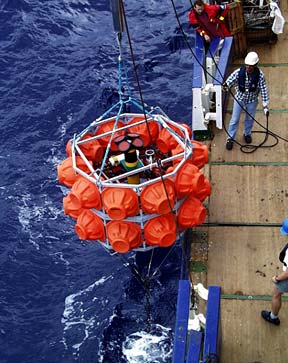Long Ranger DOMEST Project
APPLICATION: Top-to-bottom Communications with the Deep Sea Ocean Link DOMEST

Here, the ADCP buoy is lowered into the water.
It will be lowered to an ultimate depth of 3600m.
The DOMEST project examines the ocean surface exchanges and the sediments near the ocean bottom. Scientists need information about deep sea currents, resuspension of particles, particle load and “fluffy layer conditions” to study the final life stage of plankton as it dies and settles on the sea floor. Ocean plankton fixes carbon in an ocean/atmosphere carbon interchange which is a major component of the atmospheric system. Accelerated plankton growth unbalances the carbon dioxide transport from air to ocean. The resulting rapid exchange (called a “biological pump”) needs to be well understood to draw conclusions about weather changes.
The DOMEST apparatus is comprised of several different units. A surface unit telemeters data from the instruments located 60 miles north of the Canary Islands to the DOMEST headquarters in Italy, via satellite. In addition to the surface communications buoy, there is a moored sensor unit near the ocean bottom that contains an integrated sensor package to gather biological and particle density data at 3000m depth. There is also a deep ocean unit at 3600m depth containing an RDI ADCP and a CTD yo-yo system that examine bottom currents from 3600m to 3100m depth. Data from these instruments are acoustically routed to the surface and from there to Italy. Data communications is not one-way. Operators in Italy can send commands to the DOMEST instruments through the satellite link.
The DOMEST project began in the summer of 1997.















